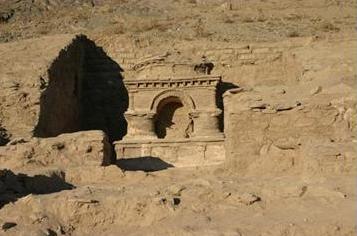
Tepe Narenj
WORLD MONUMENTS FUND
Reading time: (Number of words: )
WMF EVALUATION SUMMARY Review: Marika Sardar / WMF Staff: Angela Schuster, Gaetano Palumbo
Kabul, Afghanistan 5th - 9th centuries A.D.
SIGNIFICANCE
Tepe Narenj is a fifth- or sixth-century A.D. Buddhist monastery located in the Zanburak Mountains south of Kabul. The site comprises one large and five small stupas, cells for individual meditation, and five chapels adorned with miniature stupas, statues of Buddha, and standing Boddhisatva figures. The iconography of these statues indicates a heretofore unattested practice of Tantric Buddhism in the area. Tepe Narenj is believed to have been destroyed in the ninth century A.D. by Muslim armies, and remained forgotten until the conclusion of the war with the Soviets, when it became the first post-conflict site in Afghanistan to be excavated. The site provides valuable evidence for the expansion of Buddhism in the region, and preserves several examples of sculpture made in the unusual method of clay overlaid with fabric and covered with stucco.
THREAT Having been recently excavated, the monastery is now subject to erosion and weather conditions harmful to its fragile clay sculpture and building material. Although the Institute of Archaeology in Kabul has overseen the temporary consolidation of the in-situ sculpture and the tops of the walls, exposure and water infiltration remain the most significant threats. Unprotected, Tepe Narenj currently attracts grazing animals and curious locals, and as the city of Kabul expands, the site is in danger of being overtaken by modern buildings. In addition, the monastery is in close proximity to an area of armed conflict. Because of the extremely fragile nature of the building materials used at Tepe Narenj, it is estimated that the site can survive no more than two years of exposure.
VIABILITY The nominator is the director of excavations at Tepe Narenj and a member of the Afghan Institute of Archaeology. He proposes a series of immediate and basic measures to protect the site: the erection of a barbed-wire fence and trees to surround and protect it; a building to house round-the-clock guards; and a shelter to cover the five chapels. The nominator also requests funding for qualified conservators to consolidate the sculpture and excavated structures of the monastery. He estimates a total cost of $75,000, of which no funds are available locally due to the political situation.
ADDITIONAL CONSIDERATIONS PERTINENT TO WATCH LISTING Tepe Narenj is one of three nominations from Afghanistan this year and one of two from the Kabul area.

Poems for the Hazara
The Anthology of 125 Internationally Recognized Poets From 68 Countries Dedicated to the Hazara
Order Now









Forum posts
31 December 2007, 16:43
very nice place.